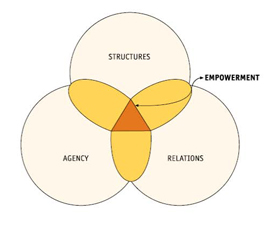Cracking the Nut 2012: Designing successful interventions to empower women
How can development practitioners and the private sector effectively implement interventions that break down social barriers and empower women in agricultural value chains? What are the key ingredients to a successful, gender-based approach? During a session on “Tapping New Markets for Women-Owned Cashew Processing in Asia” at the 2012 Cracking the Nut Conference, Laté Lawson-Lartego of CARE explored these questions. He illustrated CARE’s experience, approach, and methodology working with Walmart on the Cashew Value Chain Initiative in India.
In southern India, there are 300,000 cashew farmers and 500,000 processors. In the cashew industry, the majority of unskilled laborers are women who lack any real opportunities for advancement. These women have limited authority in decision-making and lack control over productive assets. These issues are compounded by minimal education, healthcare, and rights awareness.
Through the partnership with the Walmart Foundation, CARE launched a Cashew Value Chain Initiative in November 2009 to improve economic opportunities for women in southern India. Lawson-Lartego explained that the team began by building trust and seeking to understand the women’s circumstances and future aspirations. They then examined these definitions against the organization’s tried and true methodology. CARE defines and measures its contributions to women’s empowerment as the sum total of changes in agency (her aspirations and capabilities), structure (the environment that surrounds and conditions her choices), and relations (power dynamics through which she negotiates her path).
 Lawson-Lartego explained that the dynamic process of working towards women’s empowerment requires interventions in each of the three areas. The beauty of this framework lies in its ability to translate an abstract concept into measurable outcomes. CARE identified 23 key dimensions of social change relevant to women’s empowerment – such as self-esteem, education, political representation, and negotiation habits – through which they measure evidence of agency, structural, and relational change. From the women’s aspirations and this framework, the Cashew Value Chain Initiative focused its work and identified key interventions in the areas of promoting social empowerment and developing cashew enterprises that empower women.
Lawson-Lartego explained that the dynamic process of working towards women’s empowerment requires interventions in each of the three areas. The beauty of this framework lies in its ability to translate an abstract concept into measurable outcomes. CARE identified 23 key dimensions of social change relevant to women’s empowerment – such as self-esteem, education, political representation, and negotiation habits – through which they measure evidence of agency, structural, and relational change. From the women’s aspirations and this framework, the Cashew Value Chain Initiative focused its work and identified key interventions in the areas of promoting social empowerment and developing cashew enterprises that empower women.
Currently, the initiative has helped create four women-owned and operated processing units, three of which formalized as producer companies with women-only boards, as well as a Cashew Processing Federation of 1,250 women. These units process 184 metric tons of raw cashews, generating US$280,000 in sales. CARE estimates that over 6,000 lives have been positively impacted as a result of this initiative.
However, there is still much work to be done before these enterprises reach scale. As depicted in CARE’s Social Enterprise Development Framework, the initiative has helped these processing units to reach a point of formalization. Lawson-Lartego identified business viability as the key challenge facing the project’s sustainability, particularly in developing managerial capacity and working capital. He stated that the strategies moving forward will continue to hinge around the project’s learning agenda, which allowed implementers to course correct activities.


